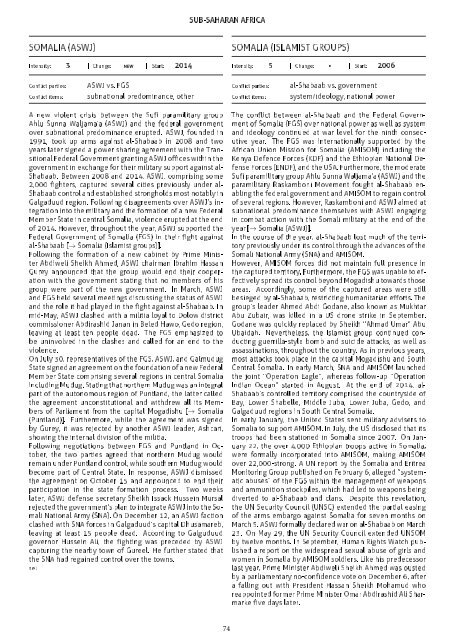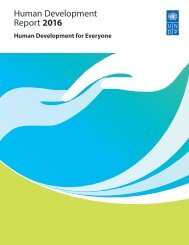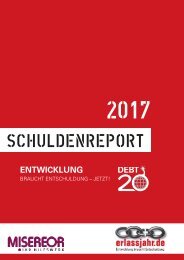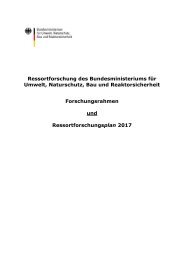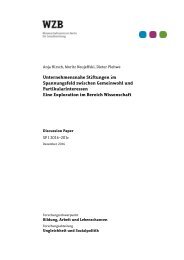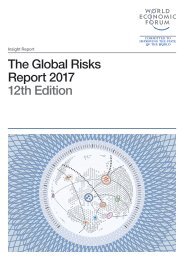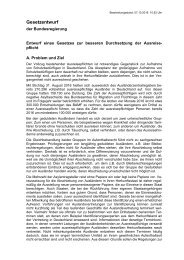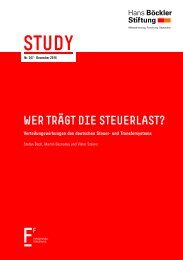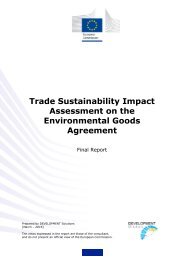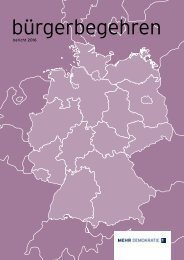79PFnGscZ
79PFnGscZ
79PFnGscZ
Create successful ePaper yourself
Turn your PDF publications into a flip-book with our unique Google optimized e-Paper software.
SUB-SAHARAN AFRICA<br />
SOMALIA (ASWJ)<br />
Intensity: 3 | Change: NEW | Start: 2014<br />
SOMALIA (ISLAMIST GROUPS)<br />
Intensity: 5 | Change: | Start: 2006<br />
Conflict parties:<br />
Conflict items:<br />
ASWJ vs. FGS<br />
subnational predominance, other<br />
Conflict parties:<br />
Conflict items:<br />
al-Shabaab vs. government<br />
system/ideology, national power<br />
A new violent crisis between the Sufi paramilitary group<br />
Ahlu Sunna Waljama'a (ASWJ) and the federal government<br />
over subnational predominance erupted. ASWJ, founded in<br />
1991, took up arms against al-Shabaab in 2008 and two<br />
years later signed a power sharing agreement with the Transitional<br />
Federal Government granting ASWJ offices within the<br />
government in exchange for their military support against al-<br />
Shabaab. Between 2008 and 2014, ASWJ, comprising some<br />
2,000 fighters, captured several cities previously under al-<br />
Shabaab control and established strongholds most notably in<br />
Galgaduud region. Following disagreements over ASWJ's integration<br />
into the military and the formation of a new Federal<br />
Member State in central Somalia, violence erupted at the end<br />
of 2014. However, throughout the year, ASWJ supported the<br />
Federal Government of Somalia (FGS) in their fight against<br />
al-Shabaab [→ Somalia (Islamist groups)].<br />
Following the formation of a new cabinet by Prime Minister<br />
Abdiweli Sheikh Ahmed, ASWJ chairman Ibrahim Hassan<br />
Gurey announced that the group would end their cooperation<br />
with the government stating that no members of his<br />
group were part of the new government. In March, ASWJ<br />
and FGS held several meetings discussing the status of ASWJ<br />
and the role it had played in the fight against al-Shabaab. In<br />
mid-May, ASWJ clashed with a militia loyal to Dolow district<br />
commissioner Abdirashid Janan in Beled Hawo, Gedo region,<br />
leaving at least ten people dead. The FGS emphasized to<br />
be uninvolved in the clashes and called for an end to the<br />
violence.<br />
On July 30, representatives of the FGS, ASWJ, and Galmudug<br />
State signed an agreement on the foundation of a new Federal<br />
Member State comprising several regions in central Somalia<br />
including Mudug. Stating that northern Mudug was an integral<br />
part of the autonomous region of Puntland, the latter called<br />
the agreement unconstitutional and withdrew all its Members<br />
of Parliament from the capital Mogadishu [→ Somalia<br />
(Puntland)]. Furthermore, while the agreement was signed<br />
by Gurey, it was rejected by another ASWJ leader, Ashcari,<br />
showing the internal division of the militia.<br />
Following negotiations between FGS and Puntland in October,<br />
the two parties agreed that northern Mudug would<br />
remain under Puntland control, while southern Mudug would<br />
become part of Central State. In response, ASWJ dismissed<br />
the agreement on October 15 and announced to end their<br />
participation in the state formation process. Two weeks<br />
later, ASWJ defense secretary Sheikh Issack Hussein Mursal<br />
rejected the government's plan to integrate ASWJ into the Somali<br />
National Army (SNA). On December 12, an ASWJ faction<br />
clashed with SNA forces in Galgaduud's capital Dhusamareb,<br />
leaving at least 15 people dead. According to Galguduud<br />
governor Hussein Ali, the fighting was preceded by ASWJ<br />
capturing the nearby town of Gureel. He further stated that<br />
the SNA had regained control over the towns.<br />
sel<br />
The conflict between al-Shabaab and the Federal Government<br />
of Somalia (FGS) over national power as well as system<br />
and ideology continued at war level for the ninth consecutive<br />
year. The FGS was internationally supported by the<br />
African Union Mission for Somalia (AMISOM) including the<br />
Kenya Defence Forces (KDF) and the Ethiopian National Defense<br />
Forces (ENDF), and the USA. Furthermore, the moderate<br />
Sufi paramilitary group Ahlu Sunna Waljama'a (ASWJ) and the<br />
paramilitary Raskamboni Movement fought al-Shabaab enabling<br />
the federal government and AMISOM to regain control<br />
of several regions. However, Raskamboni and ASWJ aimed at<br />
subnational predominance themselves with ASWJ engaging<br />
in combat action with the Somali military at the end of the<br />
year [→ Somalia (ASWJ)].<br />
In the course of the year, al-Shabaab lost much of the territory<br />
previously under its control through the advances of the<br />
Somali National Army (SNA) and AMISOM.<br />
However, AMISOM forces did not maintain full presence in<br />
the captured territory. Furthermore, the FGS was unable to effectively<br />
spread its control beyond Mogadishu towards those<br />
areas. Accordingly, some of the captured areas were still<br />
besieged by al-Shabaab, restricting humanitarian efforts. The<br />
group's leader Ahmed Abdi Godane, also known as Mukhtar<br />
Abu Zubair, was killed in a US drone strike in September.<br />
Godane was quickly replaced by Sheikh ''Ahmad Umar Abu<br />
Ubaidah. Nevertheless, the Islamist group continued conducting<br />
guerrilla-style bomb and suicide attacks, as well as<br />
assassinations, throughout the country. As in previous years,<br />
most attacks took place in the capital Mogadishu and South<br />
Central Somalia. In early March, SNA and AMISOM launched<br />
the joint ''Operation Eagle, whereas follow-up ''Operation<br />
Indian Ocean started in August. At the end of 2014, al-<br />
Shabaab's controlled territory comprised the countryside of<br />
Bay, Lower Shabelle, Middle Juba, Lower Juba, Gedo, and<br />
Galgaduud regions in South Central Somalia.<br />
In early January, the United States sent military advisers to<br />
Somalia to support AMISOM. In July, the US disclosed that its<br />
troops had been stationed in Somalia since 2007. On January<br />
22, the over 4,000 Ethiopian troops active in Somalia,<br />
were formally incorporated into AMISOM, making AMISOM<br />
over 22,000-strong. A UN report by the Somalia and Eritrea<br />
Monitoring Group published on February 6, alleged ''systematic<br />
abuses of the FGS within the management of weapons<br />
and ammunition stockpiles, which had led to weapons being<br />
diverted to al-Shabaab and clans. Despite this revelation,<br />
the UN Security Council (UNSC) extended the partial easing<br />
of the arms embargo against Somalia for seven months on<br />
March 5. ASWJ formally declared war on al-Shabaab on March<br />
23. On May 29, the UN Security Council extended UNSOM<br />
by twelve months. In September, Human Rights Watch published<br />
a report on the widespread sexual abuse of girls and<br />
women in Somalia by AMISOM soldiers. Like his predecessor<br />
last year, Prime Minister Abdiweli Sheikh Ahmed was ousted<br />
by a parliamentary no-confidence vote on December 6, after<br />
a falling out with President Hassan Sheikh Mohamud who<br />
reappointed former Prime Minister Omar Abdirashid Ali Sharmarke<br />
five days later.<br />
74


